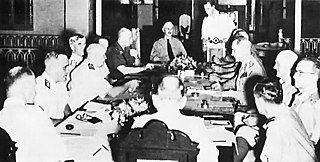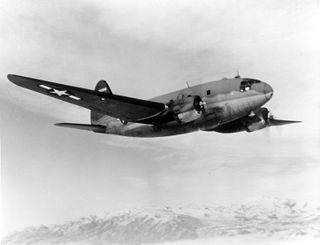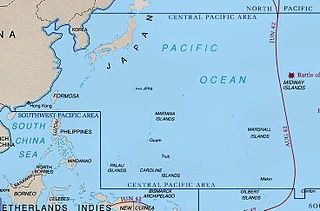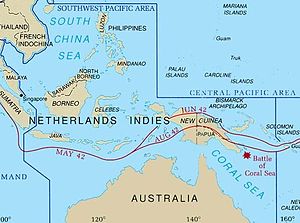
The American-British-Dutch-Australian (ABDA) Command, or ABDACOM, was the short-lived supreme command for all Allied forces in South East Asia in early 1942, during the Pacific War in World War II. The command consisted of the forces of Australia, the Netherlands, United Kingdom and the United States. The main objective of the command, led by General Sir Archibald Wavell, was to maintain control of the "Malay Barrier", a notional line running down the Malay Peninsula, through Singapore and the southernmost islands of the Dutch East Indies. ABDACOM was also known in British military circles as the "South West Pacific Command", although it should not be confused with the later South West Pacific Area command.

South West Pacific Area (SWPA) was the name given to the Allied supreme military command in the South West Pacific Theatre of World War II. It was one of four major Allied commands in the Pacific War. SWPA included the Philippines, Borneo, the Dutch East Indies, East Timor, Australia, the Territories of Papua and New Guinea, and the western part of the Solomon Islands. It primarily consisted of United States and Australian forces, although Dutch, Filipino, British and other Allied forces also served in the SWPA.

The Australian First Tactical Air Force was formed on 25 October 1944 by the Royal Australian Air Force (RAAF). Its purpose was to provide a mobile force of fighter and ground attack aircraft that could support Allied army and naval units fighting the Empire of Japan in the South West Pacific Area. One of several Allied tactical air forces formed during World War II, it evolved from the RAAF's No. 10 Operational Group, established a year earlier. Following action in the assaults on Aitape and Noemfoor, the group was renamed the First Tactical Air Force to better reflect its size and role. It was beset with morale and leadership issues in early 1945, but recovered to take part in the battles of Tarakan, North Borneo, and Balikpapan. Reaching its peak strength of over 25,000 personnel in July 1945, No. 1 TAF's squadrons operated such aircraft as the P-40 Kittyhawk, Supermarine Spitfire, Bristol Beaufighter, and B-24 Liberator. The formation remained active following the end of hostilities in the Pacific until it was disbanded on 24 July 1946.
The 91st Air Division is an inactive United States Air Force organization. Its last assignment was with Continental Air Forces, assigned to First Air Force, being stationed at Newark Municipal Airport, New Jersey. It was inactivated on 24 June 1949.

The Battle of Morotai, part of the Pacific War, began on 15 September 1944, and continued until the end of the war in August 1945. The fighting started when United States and Australian forces landed on the southwest corner of Morotai, a small island in the Netherlands East Indies (NEI), which the Allies needed as a base to support the liberation of the Philippines later that year. The invading forces greatly outnumbered the island's Japanese defenders and secured their objectives in two weeks. Japanese reinforcements landed on the island between September and November, but lacked the supplies needed to effectively attack the Allied defensive perimeter. Intermittent fighting continued until the end of the war, with the Japanese troops suffering heavy loss of life from disease and starvation.

Batchelor Airfield, is an airport located south of Batchelor, Northern Territory, Australia. The airport currently has no commercial air services; however, it is utilised by the Northern Australian Gliding Club and the Alice Springs Aero Club as a flight training base.

Fenton Airfield was a World War II military airfield in the Northern Territory of Australia located at Tipperary Station in what is now the locality of Douglas-Daly and named after flight lieutenant Clyde Fenton.

The 108th Operations Group is a unit of the 108th Wing of the New Jersey Air National Guard, one of the many units stationed at the McGuire AFB entity of Joint Base McGuire-Dix-Lakehurst, New Jersey. If activated to federal service with the U.S. Air Force, the group is gained by Air Mobility Command (AMC).

The 2d Combat Cargo Group is an inactive United States Army Air Forces unit. The unit was organized at Syracuse Army Air Base in New York. It operated during World War II in the Southwest Pacific, transporting passengers and cargo. Its last duty station under this designation was Yokota Air Base, Japan, where it was inactivated on 15 January 1946.

During World War II, the United States Army Air Forces established a series of airfields in Australia for the collective defense of the country, as well as for conducting offensive operations against the Imperial Japanese Army and Navy. From these airports and airfields in Australia, the Fifth Air Force was able to regroup, re-equip and begin offensive operations against the Empire of Japan after the disasters in the Philippines and Dutch East Indies during 1942.

The 403d Bombardment Squadron is an inactive United States Air Force unit. It was last assigned to the 43rd Bombardment Wing at Carswell Air Force Base, Texas, where it was inactivated on 1 January 1961.

The 435th Bombardment Squadron, also known as the "Kangaroo" Squadron, is an inactive United States Air Force unit. It was last assigned to the Eighth Air Force 333d Bombardment Group, based at Kadena Air Base, Okinawa. It was inactivated on 28 May 1946.

During World War II, the United States Army Air Forces fought the Empire of Japan in the Central Pacific Area. As defined by the War Department, this consisted of most of the Pacific Ocean and its islands, excluding the Philippines, Australia, the Netherlands East Indies, the Territory of New Guinea the Solomon Islands and areas to the south and east of the Solomons.

The 501st Bombardment Squadron is an inactive United States Air Force unit. It was last assigned to the 345th Bombardment Wing at Langley Air Force Base, Virginia, where it was inactivated on 25 June 1959.

The 3rd Operations Group is the operational flying component of the United States Air Force 3rd Wing. It is stationed at Joint Base Elmendorf–Richardson, Alaska, and is assigned to Pacific Air Forces' Eleventh Air Force.

This is a list of United States Army Air Forces Consolidated B-24 Liberator units and formations during World War II including variants and other historical information. Heavy bomber training organizations primarily under II Bomber Command in the United States and non-combat units are not included.

This is a list of United States Army Air Forces B-17 Flying Fortress units of the United States Army Air Forces, including variants and other historical information. Heavy bomber training organizations primarily under II Bomber Command in the United States and non-combat units are not included.

RAAF Command was the main operational arm of the Royal Australian Air Force (RAAF) during World War II. The command was formed in September 1942 and by April 1943 comprised 27 squadrons, including units from the Netherlands, the United Kingdom and the United States, as well as Australia. Coming under the operational authority of Allied Air Forces Headquarters in the South West Pacific Area, RAAF Command exercised control of its units through geographically based area commands in Australia and, later, New Guinea, as well as large mobile formations including the Australian First Tactical Air Force. The command reached a strength of 41 squadrons in October 1944. From the time of its establishment, until its disbandment in September 1945, it was led by Air Vice Marshal Bill Bostock.

North-Western Area Command was one of several geographically based commands raised by the Royal Australian Air Force (RAAF) during World War II. Its wartime sphere of operations included the Northern Territory, adjacent portions of Queensland and Western Australia, and the Dutch East Indies. The command was formed in January 1942, following the outbreak of the Pacific War, from the western part of Northern Area Command, which had covered all of northern Australia and Papua. Headquartered at Darwin, North-Western Area Command was initially responsible for air defence, aerial reconnaissance and protection of the sea lanes within its boundaries.

The 317th Operations Group is an inactive United States Air Force unit, last stationed at Pope Air Force Base, North Carolina as part of Air Mobility Command. It was activated in 1992 during the Air Force's Objective Wing reorganization, and inactivated the following year when all Air Force units at Pope were assigned to the 23d Wing.























